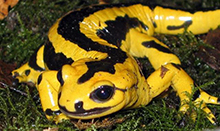
A student at Northern Arizona University (NAU), Flagstaff, is studying the way salamanders jump. The results of this work coupled with other NAU research on a muscle protein called titin have implications for possible improvements to the iWalk BiOM ankle-foot system.
Salamanders-or at least several species of the Plethodontidae family-can jump. “This particular jump is unique in the world,” said Anthony Hessel, a graduate researcher who studies muscle physiology and biomechanics.
He used high-speed film, a home-built cantilever beam apparatus, some well-established engineering equations, and biomechanical analysis to produce the details of how this amphibian with short legs can propel itself six to ten times its body length into the air. The key is that the salamander’s legs don’t provide the push that most creatures would require; instead it efficiently transfers energy from its torso into the ground.
The salamander bends its body, then rapidly pushes that bend-a C shape, down through the torso-and this movement can create a lot of elastic energy, Hessel explained “The next stage of the research is “getting down to the structures of the stiffness properties. When you see that there’s more power in the jump that can come from the muscles, then you know there are other places where you have to look, like stored elastic energy, connective tissue stretching, and bones moving.
He and his colleagues have proposed that the titin protein interacts with the muscle filaments during contractions in a way that explains muscle properties more accurately. A better understanding of muscles can possibly contribute to a better understanding of movement, such as walking and jumping.
“Using previous muscle knowledge and our new titin hypothesis, we built a new computer muscle model,” Hessel said. The new model will allow him and his colleagues to create a new control algorithm to better run a powered foot-ankle prosthesis. They have teamed up with iWalk, Bedford, Massachusetts, to use their algorithm to control its BiOM device, to see if it can reproduce normal walking better than the company’s current software.
To that extent, Hessel is analyzing the gait of individuals wearing the BiOM with either the new or old algorithms. This data will be used to inform improvements in the device.
Editor’s note: This story was adapted from materials provided by NAU and Hessel.




